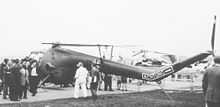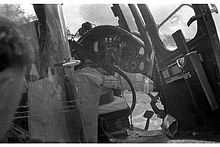Bristol Sycamore
| Type 171 Sycamore | |
|---|---|
 | |
| Bristol 171 Sycamore in Ansett-ANA service in Australia around 1960. Note possible spraying arm attachments. | |
| Role | Rescue and Anti-Submarine Helicopter |
| National origin | United Kingdom |
| Manufacturer | Bristol Aeroplane Company |
| Designer | Raoul Hafner |
| First flight | 27 July 1947 |
| Introduction | 1953 |
| Primary users | Royal Air Force Royal Australian Navy German Army |
| Produced | 1947 - 1955 |
| Number built | 180 |
|
| |
The Bristol Type 171 Sycamore was the first British-designed helicopter to fly and serve with the Royal Air Force. Created by the Bristol Aeroplane Company, it was used for search and rescue and anti-submarine warfare.
The name refers to the seeds of the Sycamore tree, Acer pseudoplatanus, which fall with a rotating motion.
Design and development
Bristol set up its Helicopter Division after the Allied invasion of Europe in 1944, when engineers from the Airborne Forces Experimental Establishment at Beaulieu became available. The AFEE had been working on the development of helicopter designs under helicopter pioneer Raoul Hafner, but the success of Horsa and Hamilcar gliders during Operation Overlord led to helicopter development now being given a priority. Hafner was appointed by Bristol as head of this new helicopter division.[1]

The design of the Sycamore commenced in June 1944, and extended over more than two years, with especial emphasis being given to the endurance of the mechanical components. The maiden flight took place on 27 July 1947, with the prototype VL958 powered by a 450 hp (340 kW) Pratt & Whitney Wasp Junior (there being no suitable engine in the Bristol range). The prototype Sycamore Mk.2 was completed in the summer of 1948, powered by a 550 hp 410 kW) Alvis Leonides; this became the standard engine for all subsequent Sycamore production.
Bristol's key development pilots for the Type 171 included Charles "Sox" Hosegood and Col. Robert "Bob" Smith, both test pilots with Bristol.
Versions of the Sycamore up to and including the Mk.3A kept to the standard two-seat aircraft layout of having the pilot in the left-hand seat and co-pilot in the right. The main production, the Mk.4, switched to the American standard practice of having the pilot's seat on the right. There were also a number of other developments from earlier versions, such as a four-door design, that were standardised for the Mk.4. This version entered RAF service as the HR14.
Civil versions did not use the name Sycamore, and were known simply as Bristol Type 171.


Operational history
The Sycamore HR14 entered service with 275 Squadron of the RAF in April 1953, and went on to serve with nine squadrons in total. It was used during the Malayan Emergency (1948-1960) for deploying Army foot patrols into the jungle. The type was used by the Royal Air Force Central Flying School for pilot training.
A total of 50 Sycamores were delivered to the German Federal Government, and three to the Belgian Government.

The Sycamore also has the distinction of being the second helicopter type to be used by the Australian Defence Force, when seven were delivered to the Royal Australian Navy.
Variants
Type 171
- Mk 1
- Prototype; two built.
- Mk 2
- Second prototype; one built.

- Mk 3
- Production model with five-seats in a widened fuselages and a shortened nose to improve visibility. Fifteen built.
- Mk 3A
- Civilian version with additional freight hold, two built for British European Airways.
- Mk 4
- This was the main production model and similar to the military version called Sycamore with a more powerful engine.
Sycamore
- Sycamore HC10
- (=Mk.3) 1 built for evaluation by the Army Air Corps as an air ambulance.
- Sycamore HC11
- (=Mk.3) 4 built for evaluation by the Army Air Corps, as communications aircraft.
- Sycamore HR12
- (=Mk.3A) 4 built for the RAF for evaluation as search and rescue aircraft.
- Sycamore HR13
- (=Mk.3A) 2 built with rescue winches for the RAF for evaluation as search and rescue aircraft.
- Sycamore HR14
- (=Mk.4) 85 built for the RAF, as search and rescue aircraft.
- Sycamore Mk 14
- 3 built for the Belgian Air Force, for use in the Belgian Congo.
- Sycamore Mk 50
- 3 built for the Royal Australian Navy, for search and rescue, and plane guard duties.
- Sycamore HC51
- 7 built for the Royal Australian Navy, for search and rescue, and plane guard duties.
- Sycamore Mk 52
- 50 built for the German Army and Navy.
Operators
Civil operators
- Australian National Airways/Ansett-ANA
- Jayrow Helicopters
- Flying Bulls In 2013 the Flying Bulls by Red Bull reinstated one Sycamore
Military operators
- Royal Australian Air Force - Only two Sycamores were in service with the RAAF from 1951 to 1965. The two helicopters were used for general support duties at the Woomera Rocket Range in South Australia.
- Aircraft Research and Development Unit
- No. 1 Air Trials unit
- Royal Australian Navy
- Belgian Air Force: Belgium used three Mk.14B's (registered as B1/OT-ZKA, B2/OT-ZKB & B3/OT-ZKC) to equipped the metropolitan power in the Congo with a rescue flight based at Kamina Air Base, Katanga Province. Used between 1954 and 1960.
- Royal Air Force
- Central Flying School
- No. 22 Squadron RAF[2]
- No. 32 Squadron RAF[2]
- No. 84 Squadron RAF[2]
- No. 103 Squadron RAF[2]
- No. 110 Squadron RAF[2]
- No. 118 Squadron RAF[2]
- No. 194 Squadron RAF[2]
- No. 225 Squadron RAF[2]
- No. 228 Squadron RAF[2]
- No. 275 Squadron RAF[2]
- No. 284 Squadron RAF[2]
- No. 651 Squadron RAF[2]
- No. 657 Squadron RAF[2]
- Army Air Corps
Specifications (Mk.4 / HR14)

Data from
General characteristics
- Crew: Two
- Capacity: accommodation for three passengers
- Payload: 1,000 lb (454 kg)
- Length: 61 ft 1¼ in (18.62 m)
- Rotor diameter: 48 ft 7 in (14.8 m)
- Height: 13 ft 10.6 in (4.23 m)
- Empty weight: 3,810 lb (1,728 kg)
- Loaded weight: 5,600 lb (2,540 kg)
- Powerplant: 1 × Alvis Leonides piston engine, 550 hp (410 kW)
Performance
- Maximum speed: 132 mph (212 km/h)
- Range: 330 mi (531 km)
- Endurance: 3½ hours
See also
- Aircraft of comparable role, configuration and era
- H-5 Dragonfly
- Westland Dragonfly
- Mil Mi-1
- Related lists
- List of aircraft of the RAF
References
- Notes
- Bibliography
- Barnes, C. H. (1964). Bristol aircraft since 1910. Putnam. ISBN 0-85177-823-2.
- Bowyer, Chaz. The Encyclopedia of British Military Aircraft. Bison Books Limited. ISBN 0-86124-258-0.
- Bridgman, Leonard, ed. Jane's All The World's Aircraft 1951–1952. London: Samson Low, Marston & Company, Ltd 1951.
- Jefford MBE, Wg Cdr C G (1988). RAF Squadrons. A comprehensive record of the movement and equipment of all RAF squadrons and their antecedents since 1912. Shrewsbury: Airlife. ISBN 1-85310-053-6.
External links
| Wikimedia Commons has media related to Bristol Sycamore. |
- RAF Museum page on the Bristol Sycamore
- helis.com pages on the Bristol Sycamore
- 171 Production list
| ||||||||||||||||||||||||||||||||||||||||||||||||||||
| ||||||||||||||||||||||